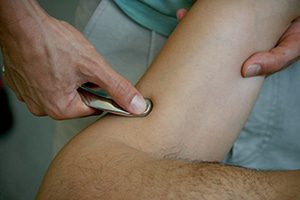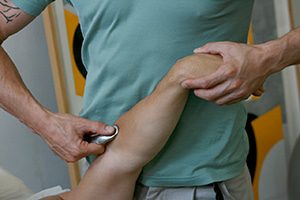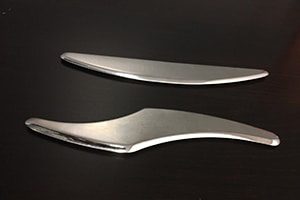Instrument assisted soft tissue uses a tool to locate and treat scar tissue or restrictions in connective tissue and muscle.
Chinese medicine uses a jade tool that resembles a comb without teeth. This technique is called Gua-Sha. It dates back to 220 BC but is still used widely today in Europe as well as the Far East.
Modern instruments are usually made of stainless steel.
These tools have a number of edges and surfaces that can be applied to various parts of the body. This has the advantage of being very specific when working on anatomical structures that are smaller or hard to reach.
Instrument Assisted Soft Tissue in Notting Hill

Using a thick oil to lubricate and protect the skin, the tool is run over a muscle or connective tissue. This often causes the skin to redden and blood flow to increase, which triggers a healing response. Patients feel an immediate release and reduction in muscle tension following a treatment in our Notting Hill Studio.
It allows a practitioner to work more intensely on a patient without straining their hands.
Movements can be added while the treatment is in progress to encourage tendons to glide within their connective tissue sleeve. The patient may be asked to move the wrist back and forth while the practitioner works on the forearm muscles.
This can help improve range of movement and reduce pain more quickly.
The practitioner is able to feel how smooth or grainy the tissue is from vibrations that pass through the tools as it runs over them. Additional pressure can then be applied to the problem areas, which helps break down scar tissue.
Collagen fibres are proteins that give structure and strength to many of the body’s tissues including muscle, ligament, tendon and bone. Scar tissue is characterized by tight and weak collagen fibres that are arranged in an abnormal and misaligned pattern. This is caused by injury or following a period of immobilisation.
Instrument assisted soft tissue is excellent for preventing the formation of excessive post-surgical scar tissue. The use of a metal instrument on scar tissue causes trauma at a microscopic level. The damaged scar tissue is absorbed and processed by immune cells. Other cells called fibroblast then deposit new collagen fibres.
Instrument assisted soft tissue is an ideal way to treat thendonopathy and tennis elbow. It works very well with Kinesio Taping and medical acupuncture.

These fibres will be orientated correctly ensuring the tissues will heal with maximum strength and flexibility. This type of treatment can be uncomfortable and sometimes leaves temporary marks or bruises.
Proven Effectiveness of Instrument Assisted Soft Tissue

Studies have shown significant improvements following this type of treatment.
After the application of this technique to an injured joint, there is not only a reduction in pain, but also an increase in the range of motion.
These types of studies measured clinical outcomes – what the patient feels, or observable differences in the patient’s ability to perform a task.
Other studies measured cellular and vascular effects and demonstrated an increase in fibroblast activity and numbers. Collagen was laid down in a more orderly way. There was a reduction in the amount of scar tissue and there was a measurable difference in the vascular effect. An increase in fluid flow means better clearance of waste products and a richer supply of nutrients and oxygen.
Increasing soft tissue health and flexibility has implications for other structures. One example is a tight band of muscle that is pulling on one side of a joint more than another. The alignment will be altered and the joint will move differently as a consequence. This can cause the joint surfaces to wear out unevenly, which increases the likelihood of premature arthritis.
Instrument assisted soft tissue can help identify these tight bands of muscle or connective tissue with far-reaching and long-term health benefits.
Another benefit of Instrument assisted soft tissue is that it saves the practitioner’s hands form the wear and tear of strong manual soft tissue work. The patient will benefit because it enables the practitioner to apply more pressure to the restricted tissues for a longer period of time.
